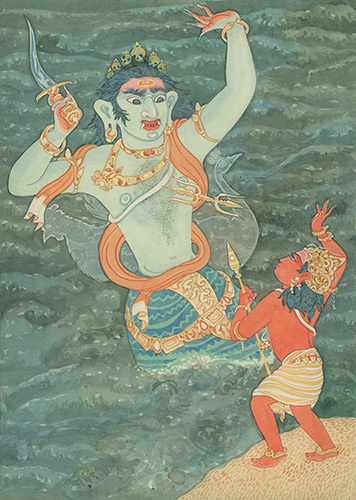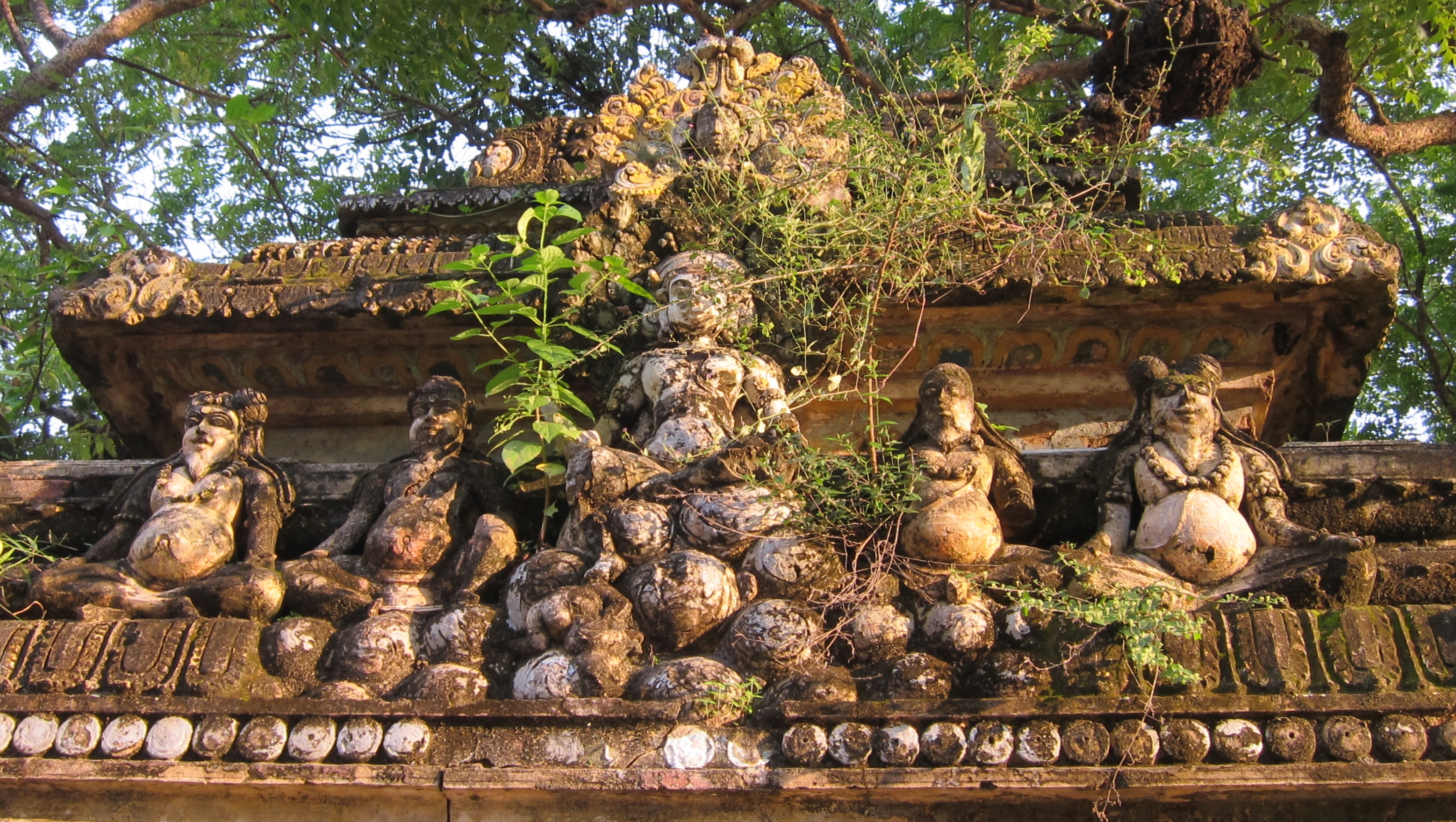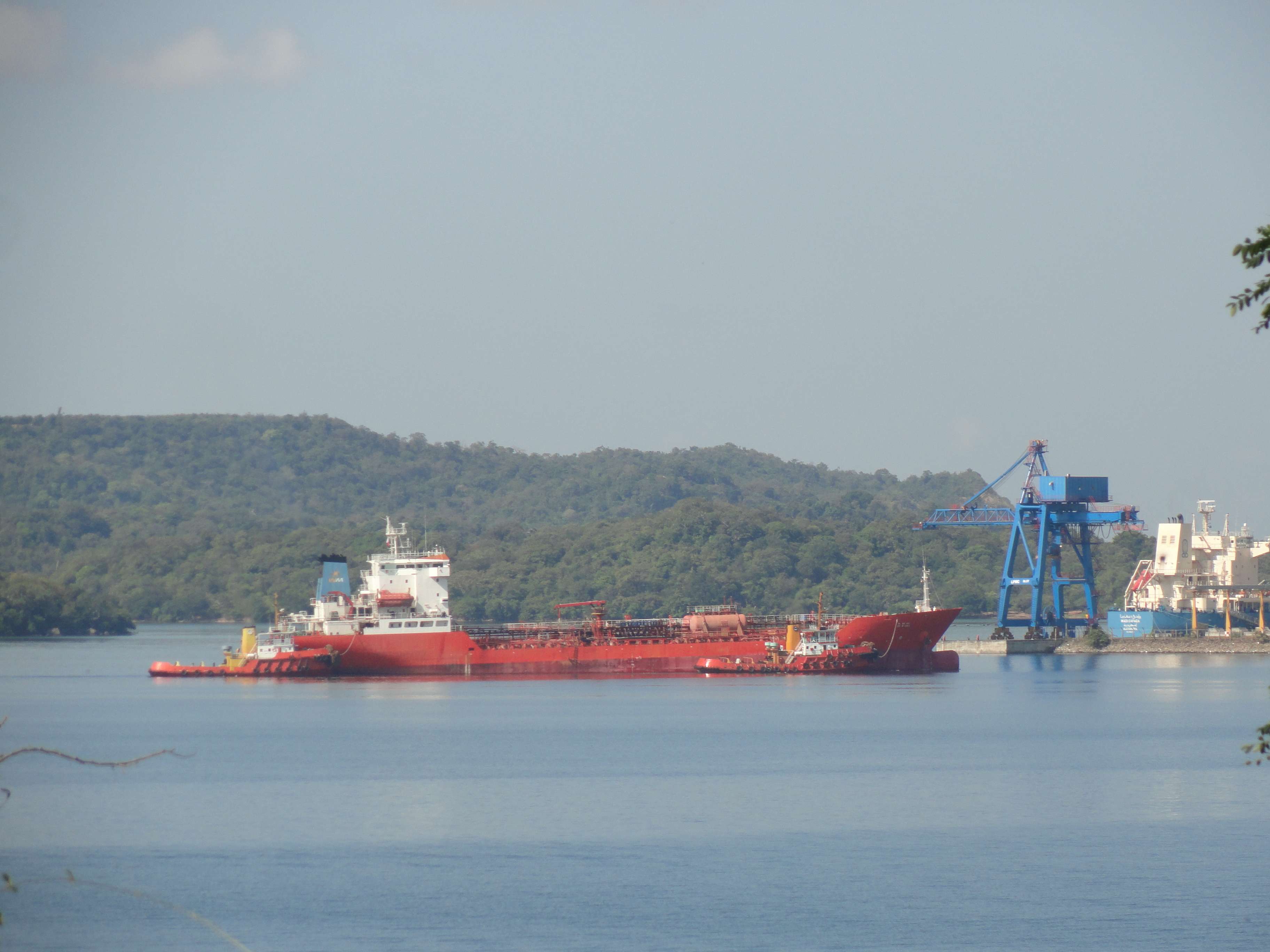|
Hinduism In Sri Lanka
Hinduism is one of Sri Lanka's oldest religions. , Hindus made up 12.6% of the Sri Lankan population. They are almost exclusively Tamils, except for small immigrant communities from India and Pakistan (including the Sindhis, Telugus and Malayalis), and the Balinese community. According to the 1915 census, Hindus made up about 25% of the Sri Lankan population (including indentured labourers brought by the British). Hinduism predominates in the Northern and Eastern Provinces (where Tamils remain the largest demographic), the central regions and Colombo, the capital. According to the 2011 census, there are 2,554,606 Hindus in Sri Lanka (12.6% of the country's population). During the Sri Lankan Civil War, many Tamils emigrated; Hindu temples, built by the Sri Lankan Tamil diaspora, maintain their religion, tradition, and culture. Most Sri Lankan Hindus follow the Shaiva Siddhanta school of Shaivism, and some follow Shaktism. Sri Lanka is home to the five abodes of Sh ... [...More Info...] [...Related Items...] OR: [Wikipedia] [Google] [Baidu] |
Hindu Temple
A Hindu temple, also known as Mandir, Devasthanam, Pura, or Kovil, is a sacred place where Hindus worship and show their devotion to Hindu deities, deities through worship, sacrifice, and prayers. It is considered the house of the god to whom it is dedicated.; Quote: "The Hindu temple is designed to bring about contact between man and the gods of Hinduism religion" (...) "The architecture of the Hindu temple symbolically represents this quest by setting out to dissolve or decrease the boundaries between man and the divine". Hindu temple architecture, which makes extensive use of squares and circles, has its roots in later Vedic traditions, which also influence the temples' construction and symbolism. Through astronomical numbers and particular alignments connected to the temple's location and the relationship between the deity and the worshipper, the temple's design also illustrates the idea of recursion and the Microcosm–macrocosm analogy, equivalency of the macrocosm and t ... [...More Info...] [...Related Items...] OR: [Wikipedia] [Google] [Baidu] |
Balinese People
The Balinese people (, ) are an Austronesian ethnic group native to the Indonesian island of Bali. The Balinese population of 4.2 million (1.7% of Indonesia's population) live mostly on the island of Bali, making up 89% of the island's population. There are also significant populations on the island of Lombok and in the easternmost regions of Java (e.g. the regency of Banyuwangi). The Balinese are distinctive amongst Indonesian ethnic groups for their adherence to Balinese Hinduism rather than Sunni Islam. Origins The Balinese originated from three periods of migration. The first waves of immigrants came from Java and Kalimantan in prehistoric times and were of Proto-Malay stock. The second wave of Balinese came slowly over the years from Java during the Hindu period. The third and final wave came from Java, between the 15th and 16th centuries, about the same time as the conversion to Islam in Java, causing aristocrats and peasants to flee to Bali after the collapse of the Ja ... [...More Info...] [...Related Items...] OR: [Wikipedia] [Google] [Baidu] |
Sinhalese People
The Sinhalese people (), also known as the Sinhalese or Sinhala people, are an Indo-Aryan peoples, Indo-Aryan ethno-linguistic group native to the island of Sri Lanka. They are the largest ethnic group in Sri Lanka, constituting about 75% of the Sri Lankan population and number more than 15.2 million. The Sinhalese people speak Sinhala language, Sinhala, an insular Indo-Aryan languages, Indo-Aryan language. Sinhalese people are predominantly Theravada Buddhists, although a significant minority of Sinhalese follow branches of Christianity in Sri Lanka, Christianity and Religion in Sri Lanka, other religions. Since 1815, Sinhalese people were broadly divided into two subgroups: the up-country Sinhalese of the Central province, Sri Lanka, central mountainous regions, and the low-country Sinhalese of the coastal regions. Although both groups speak the same language, they are distinguished as they observe different cultural customs. According to the ''Mahavamsa'', a Pali chronicle ... [...More Info...] [...Related Items...] OR: [Wikipedia] [Google] [Baidu] |
Murugan
Kartikeya (/ kɑɾt̪ɪkejə/; ), also known as Skanda ( /skən̪d̪ə/), Subrahmanya (/ sʊbɾəɦməɲjə/, /ɕʊ-/), Shanmukha ( /ɕɑnmʊkʰə/) and Murugan (/ mʊɾʊgən/), is the Hindu god of war. He is generally described as the son of the deities Shiva and Parvati and the brother of Ganesha. Kartikeya has been an important deity in the Indian subcontinent since ancient times. Mentions of Skanda in the Sanskrit literature data back to fifth century BCE and the mythology relating to Kartikeya became widespread in North India around the second century BCE. Archaeological evidence from the first century CE and earlier shows an association of his iconography with Agni, the Hindu god of fire, indicating that Kartikeya was a significant deity in early Hinduism. He is hailed as the "favoured god of the Tamils", and the tutelary deity of the Kurinji region in Sangam literature, whose cult gained popularity later. As per theologists, the Tamil deity of Murugan coalesced ... [...More Info...] [...Related Items...] OR: [Wikipedia] [Google] [Baidu] |
Ravana
According to the Mahakavya, Hindu epic, ''Ramayana'', Ravana was a kingJustin W. Henry, ''Ravana's Kingdom: The Ramayana and Sri Lankan History from Below'', Oxford University Press, p.3 of the island of Lanka, in which he is the chief antagonist and is considered to be a Rakshasa (demon). In the ''Ramayana'', Ravana is described as the eldest son of sage Vishrava and Kaikesi, Kaikasi. He abducted Rama's wife, Sita, and took her to his kingdom of Lanka, where he held her in the Ashok Vatika, Ashoka Vatika. Rama, with the support of vanara King Sugriva and his army of vanaras, launched a rescue operation for Sita against Ravana in Lanka. Ravana was subsequently slain, and Rama rescued his beloved wife Sita. Ravana was well-versed in the six shastras and the four Vedas, including the Shiva Tandava Stotra. Ravana is also considered to be the most revered devotee of Shiva. Images of Ravana are often seen associated with Shiva at temples. He also appears in the Buddhist Mahayana t ... [...More Info...] [...Related Items...] OR: [Wikipedia] [Google] [Baidu] |
Pancha Ishwarams
The Pancha Ishwarams (five abodes of Shiva) () are five coastal ancient kovils (temples) built in dedication to the Hindu supreme being Ishwara in the form of the god Shiva, located along the circumference of Sri Lanka. The most sacred pilgrimage complexes for Sri Lankan Tamil devotees of Hinduism, they adhere to the ancient Saiva Siddhanta philosophy with central shrines for Shiva in each temple. Initial construction was by royal architects of the Naga kingdom (Nayanar). The Shiva lingams in each kovil are recorded as being Ravana's installations, while one of his descendants, the ancient Yaksha queen Kuveni was a devotee of Ishwara. Eventually, the kovils became international focal points of their classical era capitals in their respective districts, maintaining their own historical records, traditions and broad influence across Asia. Figures such as Agastya, Rama, Ravana and Arjuna – featured with the temples in ''Sthala Puranas'', local ''Maanmiyams'', ''Mahabharata'' ... [...More Info...] [...Related Items...] OR: [Wikipedia] [Google] [Baidu] |
Shaiva Siddhanta
Shaiva Siddhanta () is a form of Shaivism popular in a pristine form in Tamilnadu and Sri Lanka and in a Tantrayana syncretised form in Vietnam and Indonesia (as Siwa Siddhanta). It propounds a devotional philosophy with the ultimate goal of experiencing union with Shiva. The former draws primarily on the Tamil devotional hymns written by Shaiva saints from the 5th to the 9th century CE, known in their collected form as ''Tirumurai''. Tirumular, an aide of the prime Sangam age Vedic rishi Agastya, is considered to be the propounder of the term Siddhanta and its basic tenets in his ''magnum opus''. In the 12th century, Aghorasiva, the head of a branch monastery of the Amardaka order in Chidambaram, took up the task of formulating Shaiva Siddhanta. This is an earliest known Aghora Paddhati system of Shaiva Siddhanta of Adi Shaivas '' matha''s in Kongu Nadu. The Brahma Sutra Bhashya of Śrīkaṇṭhācārya Śivācārya is a further Agamic philosophical foundation of the phi ... [...More Info...] [...Related Items...] OR: [Wikipedia] [Google] [Baidu] |
Sri Lankan Tamil Diaspora
The Sri Lankan Tamil diaspora refers to the global diaspora of Sri Lankan Tamil origin. It can be said to be a subset of the larger Sri Lankan and Tamil diaspora. Like other diasporas, Sri Lankan Tamils are scattered and dispersed around the globe, with concentrations in South Africa, United Kingdom, Canada, India, Europe, Australia, United States, Malaysia, Singapore, Seychelles and Mauritius. British colonial period In foreign lands under British rule, the British needed obedient, trusted, hard-working and skillful people to take up government posts, mainly as clerks. This led to the first wave of migrations by the Tamils to countries such as Malaysia (then Malaya), Singapore and the then Madras Presidency in India. Unlike the Tamil diaspora from India, there was much less migration from Sri Lanka to British colonies. Malaysia and Singapore Ceylonese Tamils made up an overwhelming majority in the civil service of British Malaya and Singapore prior to independence. It ... [...More Info...] [...Related Items...] OR: [Wikipedia] [Google] [Baidu] |
Tamils
The Tamils ( ), also known by their endonym Tamilar, are a Dravidian peoples, Dravidian ethnic group who natively speak the Tamil language and trace their ancestry mainly to the southern part of the Indian subcontinent. The Tamil language is one of the longest-surviving classical languages, with over two thousand years of Tamil literature, written history, dating back to the Sangam period (between 300 BCE and 300 CE). Tamils constitute about 5.7% of the Indian population and form the majority in the South Indian state of Tamil Nadu and the union territory of Puducherry (union territory), Puducherry. They also form significant proportions of the populations in Sri Lankan Tamils, Sri Lanka (15.3%), Tamil Malaysians, Malaysia (7%) and Indian Singaporeans, Singapore (5%). Tamils have migrated world-wide since the 19th century CE and a significant population exists in South Africa, Mauritius, Fiji, as well as other regions such as the Southeast Asia, Middle East, Caribbean and parts ... [...More Info...] [...Related Items...] OR: [Wikipedia] [Google] [Baidu] |
Eastern Province, Sri Lanka
The Eastern Province ( ''Næ̆gĕnahira Paḷāta'' , ''Kiḻakku Mākāṇam'') is one of the nine provinces of Sri Lanka, the first level administrative division of the country. The provinces have existed since the 19th century but did not have any legal status until 1987 when the 13th Amendment to the Constitution of Sri Lanka established Provincial Councils (Sri Lanka), provincial councils. Between 1988 and 2006 the province was temporarily Merger (politics), merged with the Northern Province, Sri Lanka, Northern Province to form the North Eastern Province, Sri Lanka, North Eastern Province. The Capital city, capital of the province is Trincomalee. Kalmunai is the largest and most populous city of Eastern Province. History In 1815 the British gained control of the entire island of Ceylon. They divided the island into three ethnic based administrative structures: Low Country Sinhalese, Kandyan Sinhalese and Tamils, Tamil. The Eastern Province was part of the Tamil administra ... [...More Info...] [...Related Items...] OR: [Wikipedia] [Google] [Baidu] |
Northern Province, Sri Lanka
The Northern Province ( ''Vaṭa Mākāṇam''; ''Uturu Paḷāta'') is one of the nine Provinces of Sri Lanka, provinces of Sri Lanka. The province has an area of 8,884 km2, making it the 3rd largest province by area, and a population of 1,061,315, making it the least populated province. Jaffna is the capital city of the province. Between 1988 and 2006, the province was temporarily Merger (politics), merged with the Eastern Province, Sri Lanka, Eastern Province into one province, the North Eastern Province, Sri Lanka, North Eastern Province. Due to its large Sri Lankan Tamil people, Tamil population, the Northern Province is sometimes referred to as "Sri Lanka's Tamil country". The majority of the fighting in the Sri Lankan civil war, Sri Lankan Civil War took place in the Northern province. History Parts of present-day Northern Province were part of the pre-colonial Jaffna kingdom. Other parts were ruled by Vanniar (Chieftain), Vanniar Chieftains who paid tribute to the Jaffna ... [...More Info...] [...Related Items...] OR: [Wikipedia] [Google] [Baidu] |





